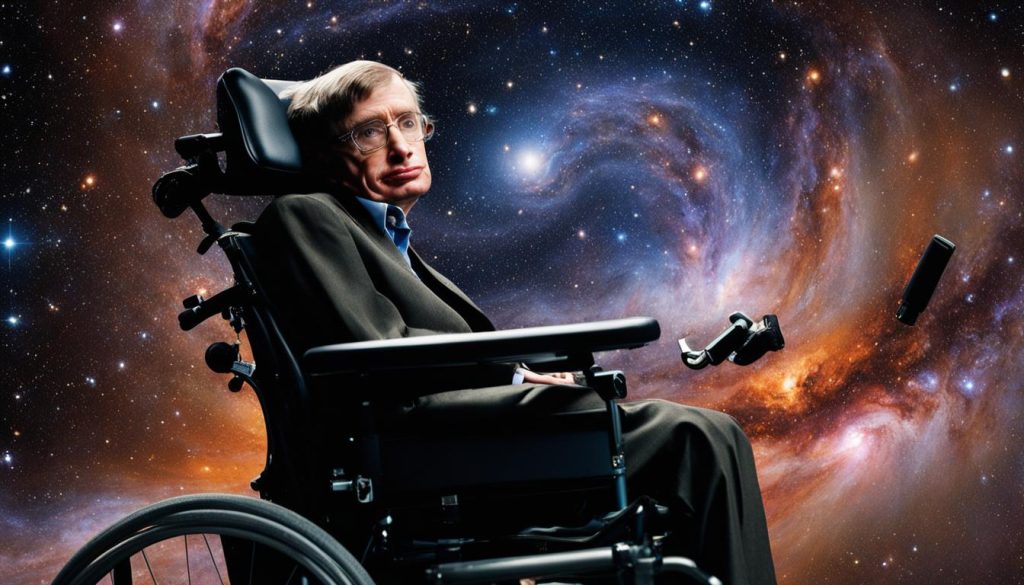When it comes to famous disabled celebrities, there are plenty of renowned individuals with disabilities who have not only overcome their challenges but have also become iconic figures in their fields. From artists and mathematicians to scientists and actors, these prominent disabled personalities have left a lasting impact on the world, inspiring others with their stories of resilience and triumph.
Key Takeaways:
- Famous disabled individuals have achieved great success and fame in various fields.
- Their stories of resilience and triumph inspire people all over the world.
- Well-known disabled role models prove that disabilities do not define a person’s potential.
- Influential figures with disabilities serve as a source of inspiration for others.
- Famous people overcoming disabilities show that anything is possible with determination and perseverance.
Frida Kahlo: Overcoming Physical Challenges to Become an Iconic Artist
Frida Kahlo, the famous Mexican artist, is widely recognized for her unique style and powerful self-portraits. But what many may not know is that Kahlo overcame numerous physical challenges throughout her life, making her an inspirational figure for artists with disabilities and beyond.
Despite being afflicted by polio as a child, Kahlo developed a passion for art and pursued it unwavering determination. Additionally, she faced the constant pain and limitations caused by spina bifida and dysmetria in her right leg. Bedridden for extended periods, Kahlo used her art as an outlet for self-expression and to navigate her physical and emotional struggles.
By transforming her pain into art, Kahlo’s work became a reflection of her personal experiences and a testament to her resilience. Her distinctive style, characterized by vibrant colors, symbolic imagery, and deeply reflective themes, resonates with audiences worldwide. Through her paintings, Kahlo confronted and confronted societal norms, challenged conventional beauty standards, and conveyed a message of empowerment and authenticity.
“I paint myself because I am often alone and because I am the subject I know best,” Kahlo once said. Her self-portraits, marked by their raw honesty and vulnerability, continue to captivate viewers and inspire artists to embrace their own unique perspectives.


Frida Kahlo’s journey as an artist and her ability to overcome physical challenges serve as an inspiration to individuals with disabilities, artists, and anyone facing adversity. Through her art, Kahlo proved that creativity has no boundaries and that one’s unique experiences can be transformed into powerful expressions of self. Her legacy as an iconic artist with disabilities inspires generations and reminds us that our differences should be celebrated, not limitations.
The Influence of Frida Kahlo’s Art
Kahlo’s impact extends beyond her artistry, inspiring countless artists, musicians, and writers. Her art has become a symbol of strength, resilience, and the triumph of the human spirit. Through her self-portraits, Kahlo challenged societal norms and paved the way for marginalized voices to be heard.
- Kahlo’s art helped redefine the traditional role of women in art and society, opening doors for female artists to explore their identities and experiences.
- Her exploration of pain, love, and identity resonates with individuals of diverse backgrounds, fostering a sense of inclusivity and empathy.
- By embracing her Mexican heritage and incorporating indigenous culture into her artwork, Kahlo celebrated her roots and became a symbol of national pride.
- Her artistic legacy has inspired musicians, such as Madonna and Lila Downs, who have paid homage to Kahlo’s spirit and resilience in their music.
Frida Kahlo’s ability to overcome physical challenges and channel her experiences into influential art continues to inspire artists and individuals worldwide. Her iconic self-portraits and unique artistic style have left an indelible mark on the art world, testament the enduring power of creativity and personal expression.
| Legacy of Frida Kahlo | Influence |
|---|---|
| Iconic self-portraits | Inspiration for artists |
| Celebration of Mexican culture | Symbol of national pride |
| Challenging societal norms | Empowering marginalized voices |
| Resilience and strength | Inspiration for Musicians |
John Nash: Brilliant Mathematician Battling Paranoid Schizophrenia
In the world of mathematics, one name stands out for both its brilliance and the personal struggles its owner faced. John Nash, a prominent disabled personality, was a mathematician who battled paranoid schizophrenia throughout his life. Despite his challenges, Nash’s contributions to the field were remarkable, and his story serves as a testament to triumph in the face of adversity.
Nash’s journey as a mathematician began with promising achievements. He made significant breakthroughs early in his career, becoming a prominent figure in game theory. However, in 1959, he was diagnosed with paranoid schizophrenia, a mental illness that would shape the rest of his life. Despite his overwhelming obstacles, Nash continued his work and even received the Nobel Prize in Economics in 1994 for his contributions to the field.
Nash’s story was brought to a broader audience through the critically acclaimed film “A Beautiful Mind.” The movie depicted his struggles with mental illness and showcased his determination to overcome them. It highlighted his resilience and the strength of his mind, leading viewers to gain a deeper understanding of the challenges faced by individuals battling mental health issues.
Triumph through Adversity
John Nash’s life inspires many, demonstrating that disability and mental illness do not have to hinder one’s potential for greatness. His ability to navigate the complexities of his condition while still making significant contributions to the field of mathematics is a testament to his indomitable spirit. Nash truly exemplifies the power of the human mind and the potential for triumph, even in the face of adversity.
John Nash left a lasting legacy in mathematics through his groundbreaking work and unwavering dedication. His story continues to resonate with individuals across the globe, reminding us that disabilities and mental illness should never limit our aspirations or hinder our pursuit of greatness.
John Nash’s Achievements
| Year | Accomplishment |
|---|---|
| 1950 | Publishes “Non-Cooperative Games,” a groundbreaking paper in game theory. |
| 1994 | Received the Nobel Prize in Economics for his contributions to the field. |
| 2002 | Inducted into the National Academy of Sciences. |


Stephen Hawking: A Brilliant Mind Defying the Limits of ALS
Stephen Hawking, widely regarded as one of the most influential figures with disabilities, overcame remarkable challenges to become a renowned scientist and an inspirational figure for individuals with disabilities worldwide. Diagnosed with amyotrophic lateral sclerosis (ALS) at the age of 21, Hawking defied the limits imposed by his condition and continued to push the boundaries of scientific knowledge.
Despite being paralyzed from head to toe and relying on a wheelchair and voice synthesizer to communicate, Hawking’s brilliance shone through his groundbreaking research. He contributed significant breakthroughs in cosmology and theoretical physics, including his work on black holes and the theory of everything. Hawking captivated audiences and expanded our understanding of the universe through his numerous publications and lectures.
“My advice to other disabled people would be, concentrate on things your disability doesn’t prevent you doing well, and don’t regret the things it interferes with. Don’t be disabled in spirit as well as physically.” – Stephen Hawking
Hawking’s extraordinary life and achievements were depicted in the critically acclaimed film “The Theory of Everything,” which delved into his personal and professional challenges. The movie shed light on his determination, resilience, and unwavering pursuit of knowledge despite his obstacles.
Stephen Hawking’s legacy is a testament to the power of the human spirit and the capacity to overcome disabilities. He inspires individuals with disabilities, showing that with unwavering determination and a brilliant mind, one can defy the limits imposed by physical conditions and make profound contributions to the world.


The Life and Achievements of Stephen Hawking:
| Birth | January 8, 1942 |
|---|---|
| Diagnosis of ALS | 1963 |
| Publication of “A Brief History of Time” | 1988 |
| Knighted by Queen Elizabeth II | 2008 |
| Death | March 14, 2018 |
Conclusion
In conclusion, the stories of famous people with disabilities are a powerful reminder of the resilience and triumph that can arise from facing and overcoming challenges. These individuals have not only achieved greatness in their respective fields but have also become inspirational figures for people with disabilities worldwide.
Through their determination and perseverance, these iconic figures have shattered societal barriers and proven that disabilities know no boundaries when achieving success. Their stories of resilience and triumph resonate deeply with individuals who face physical or mental challenges, showing them that anything is possible with the right mindset and support.
By showcasing the potential and accomplishments of famous disabled celebrities like Frida Kahlo, John Nash, and Stephen Hawking, we are reminded that disabilities do not define a person’s worth or limit their capacity for greatness. These individuals have made significant contributions to their respective fields and inspired countless others to embrace their unique abilities and strive for their dreams.
Ultimately, the stories of these inspirational figures with disabilities teach us that no matter what challenges we face, we can rise above them and achieve greatness. By embracing our resilience and determination, we can overcome any obstacle and succeed in our lives, proving that disabilities are not barriers but merely aspects of our diverse and extraordinary human experience.
FAQ
Who are some well-known individuals with disabilities?
Some well-known individuals with disabilities include Frida Kahlo, John Nash, Stephen Hawking, Nick Vujicic, Andrea Bocelli, Michael J. Fox, Alex Zanardi, and Aaron Fotheringham.
What disabilities did Frida Kahlo face?
Frida Kahlo had polio as a child and suffered from spina bifida and dysmetria in her right leg.
What contributions did John Nash make despite battling paranoid schizophrenia?
John Nash made significant contributions to the field of mathematics and was awarded the Nobel Prize in Economics in 1994 for his work on game theory.
How did Stephen Hawking continue his research despite being paralyzed?
Stephen Hawking, diagnosed with amyotrophic lateral sclerosis (ALS), continued his groundbreaking research using a wheelchair and voice synthesizer.
Why are these individuals considered inspirational figures?
These individuals are considered inspirational figures because they have overcome physical and mental challenges to achieve greatness in their respective fields, serving as role models and inspiration for people with disabilities worldwide.
What do the stories of Frida Kahlo, John Nash, and Stephen Hawking teach us?
The stories of Frida Kahlo, John Nash, and Stephen Hawking remind us that disabilities do not define a person’s potential and that with determination and perseverance, anything is possible.


